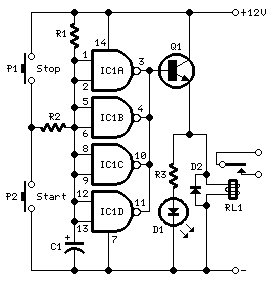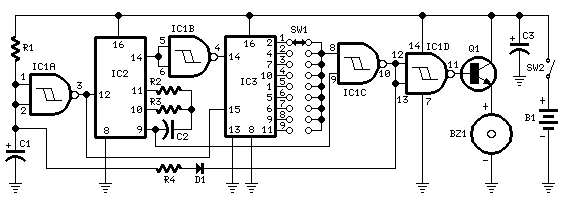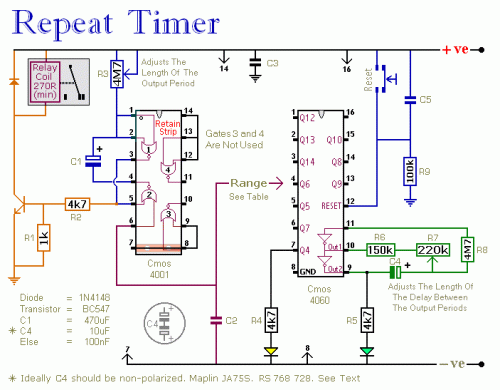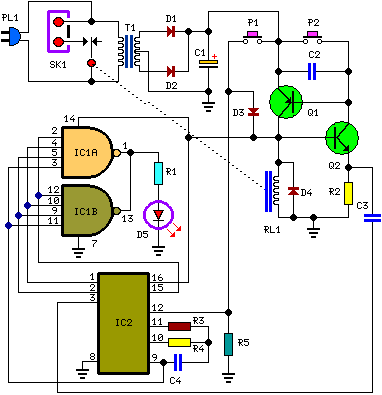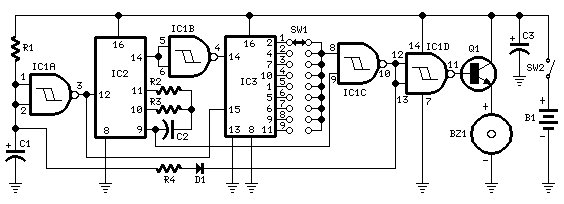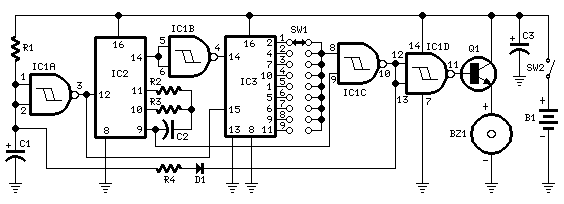
Jogging TimerCircuit
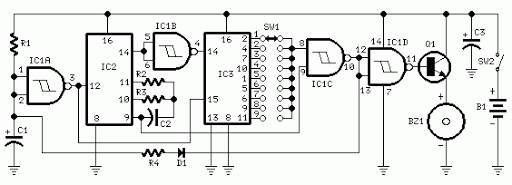
3V battery-powered circuit that emits a beep after a fixed delay of several minutes. This circuit was created in response to requests from users seeking a timer functionality.
The described circuit operates on a 3V power supply, making it suitable for battery operation. It is designed to emit a sound signal after a predetermined delay, which can be adjusted according to user requirements. The primary components involved in this circuit typically include a timer IC, a piezo buzzer, resistors, and capacitors.
The timer IC, such as the NE555, is commonly used in this type of application due to its versatility and ease of use. In astable mode, the NE555 can be configured to produce a pulse output that triggers the piezo buzzer. The timing interval is determined by the values of the resistors and capacitors connected to the IC. By selecting appropriate resistor and capacitor values, the delay can be set to the desired duration.
The circuit begins its operation when powered on, with the timer initiating its countdown. Once the set time elapses, the output pin of the timer IC goes high, activating the piezo buzzer. The buzzer then produces an audible beep, alerting the user that the timer has completed its cycle.
Additional features may include an LED indicator that illuminates during the countdown phase and turns off when the beep is activated, providing a visual cue to the user. The circuit can be further enhanced with a reset button, allowing users to restart the timer without removing the power supply.
Overall, this circuit serves a practical purpose for various applications where a simple timing alert is required, such as kitchen timers, reminders, or alert systems in different environments. The straightforward design and low power consumption make it an efficient solution for battery-operated devices.3V Battery powered, Beeps after a fixed minutes delay This circuit was developed since a number of visitors of this website requested a timer capable of e.. 🔗 External reference
The described circuit operates on a 3V power supply, making it suitable for battery operation. It is designed to emit a sound signal after a predetermined delay, which can be adjusted according to user requirements. The primary components involved in this circuit typically include a timer IC, a piezo buzzer, resistors, and capacitors.
The timer IC, such as the NE555, is commonly used in this type of application due to its versatility and ease of use. In astable mode, the NE555 can be configured to produce a pulse output that triggers the piezo buzzer. The timing interval is determined by the values of the resistors and capacitors connected to the IC. By selecting appropriate resistor and capacitor values, the delay can be set to the desired duration.
The circuit begins its operation when powered on, with the timer initiating its countdown. Once the set time elapses, the output pin of the timer IC goes high, activating the piezo buzzer. The buzzer then produces an audible beep, alerting the user that the timer has completed its cycle.
Additional features may include an LED indicator that illuminates during the countdown phase and turns off when the beep is activated, providing a visual cue to the user. The circuit can be further enhanced with a reset button, allowing users to restart the timer without removing the power supply.
Overall, this circuit serves a practical purpose for various applications where a simple timing alert is required, such as kitchen timers, reminders, or alert systems in different environments. The straightforward design and low power consumption make it an efficient solution for battery-operated devices.3V Battery powered, Beeps after a fixed minutes delay This circuit was developed since a number of visitors of this website requested a timer capable of e.. 🔗 External reference
